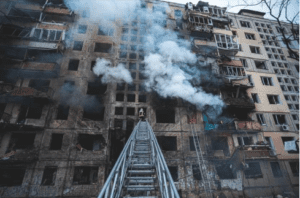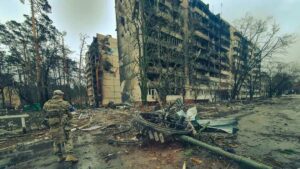
Losses among civilians from February 24, when Russia started the war against Ukraine, until 24:00 on April 4 amounted to 3675 civilians (in the report the day before – 3527), including 1480 dead (1430), reports the Office of the UN High Commissioner for Human Rights on Tuesday.
“OHCHR believes that the actual figures are much higher as information is delayed from some areas of intense fighting and many reports are still awaiting confirmation,” the document says.
According to him, this applies, for example, to Mariupol and Volnovakha (Donetsk region), Izyum (Kharkiv region), Popasnaya (Luhansk region), Borodyanka (Kyiv region), where there are reports of numerous civilian casualties. They are subject to further verification and are not included in the above statistics.
“The majority of civilian deaths or injuries were caused by the use of explosive devices with a wide area of effect, including shelling from heavy artillery and multiple launch rocket systems, as well as rocket and air strikes,” the report says.
According to confirmed UN data, 331 men, 211 women, 40 boys and 22 girls died, while the sex of 61 children and 815 adults has not yet been determined.
Among the 2,195 injured, 43 are girls and 40 boys, as well as 100 children, whose sex has not yet been determined.
Compared to the previous day, two children were killed and five injured, according to the UN.
OHCHR indicates that in Donetsk and Luhansk regions, as of midnight April 5, there were 407 (405) dead and 808 (793) injured in government-controlled territory, and 67 (67) dead and 257 (253) injured in territory controlled by self-proclaimed “republics”.
In other regions of Ukraine under government control (in Kyiv, as well as in Zhytomyr, Zaporozhye, Kiev, Sumy, Odessa, Mykolaiv, Kharkiv, Kherson, Dnepropetrovsk, Cherkasy and Chernihiv regions), the UN recorded 1006 (958) dead and 1130 (1051) injured .
The report also states that, according to the Office of the Prosecutor General of Ukraine, as of 08:00 on April 5, 165 (161) children were killed and 266 (264) were injured.
The increase in indicators in this report compared to the figures in the previous report should not be attributed only to new cases that occurred on April 4, since during the day OHCHR also verified a number of cases that occurred in previous days, the document specifies.

Losses among civilians from February 24, when Russia started the war against Ukraine, until 24:00 on April 3, 2022, amounted to 3527 civilians (3455 in the report a day earlier), including 1430 dead (1417), reports the Office of the UN High Commissioner for human rights on Monday.
“OHCHR believes that the actual figures are much higher as information is delayed from some areas of intense fighting and many reports are still awaiting confirmation,” the document says.
According to him, this applies, for example, to Mariupol and Volnovakha (Donetsk region), Izyum (Kharkiv region), Popasna (Luhansk region), Irpin (Kyiv region), where there are reports of numerous civilian casualties. They are subject to further verification and are not included in the above statistics.
“The majority of civilian deaths or injuries were caused by the use of explosive devices with a wide area of effect, including shelling from heavy artillery and multiple launch rocket systems, as well as rocket and air strikes,” the report says.
According to confirmed UN data, 297 men, 202 women, 40 boys and 22 girls died, while the sex of 59 children and 810 adults has not yet been determined.
Among the 2,097 injured, 42 are girls and 38 boys, as well as 98 children whose gender has not yet been determined.
Compared to the previous day, seven children were injured, according to the UN.
OHCHR indicates that in Donetsk and Luhansk regions, as of midnight on April 4, there were 405 (401) dead and 793 (784) injured in government-controlled territory, and 67 (67) dead and 253 (252) injured in territory controlled by self-proclaimed “republics”.
In other regions of Ukraine under government control (in Kyiv, as well as in Zhytomyr, Zaporozhye, Kiev, Sumy, Odessa, Mykolaiv, Kharkiv, Kherson, Dnipropetrovsk, Cherkasy and Chernihiv regions), the UN recorded 958 (949) dead and 1051 (1002) injured .
The report also states that, according to the Office of the Prosecutor General of Ukraine, as of 08:00 on April 4, 161 (158) children were killed and 264 (258) were injured.
The increase in indicators in this report compared to the figures in the previous report should not be attributed only to new cases that occurred on April 3, since OHCHR also verified a number of cases that occurred in previous days during the day, the document specifies.

The vast majority (79.2%) of refugees from Ukraine intend to return to their homeland after the end of the war, and only 10.9% do not plan to return, according to the results of a survey conducted by the Sociological Service of the Razumkov Center at checkpoints in the Transcarpathian region from March 15 to April 1.
During the survey, 101 respondents over 16 years old were interviewed, who were traveling from Ukraine on foot or by road. 89.1% are sure that Ukraine will win this war, only 1% are sure that it will lose, the rest found it difficult to answer.
83.2% of refugees are women. 63.4% travel with their children and only 12.9% on their own.
36.6% – leaving the country at the age of 30-39, 25.7% – 40-49 years old, 18.8% – 16-29 years old, 10.9% – over 60 years old and 7.9% at the age of 50 -59 years old.
The relative majority of refugees are from Kyiv and Kharkov regions (18.8% each), slightly less from Kiev (11.9%), Donetsk (7.9%), Zaporozhye (6.9%), Mykolaiv, Odessa, Kherson ( by 5%) regions. No one left Volyn, Lvov, Khmelnytsky, Ivano-Frankivsk, Chernivtsi, Ternopil regions. 55.4% stated that they left the settlement where the hostilities took place, 12.9% – that the hostilities took place nearby, 9.9% – that there were no hostilities, but their locality was bombarded or shelled, 13.9 % – that this happened in a neighboring settlement, and only 7.9 noted that there were no hostilities and shooting either in their settlement or nearby.
26.7% reported that they received assistance from government agencies, 53.5% – from volunteers, 8.9% – from religious organizations, 6.9% – from enterprises (including at the place of work), 40, 6% – from relatives and friends, 44.6% – from unfamiliar fellow citizens, only 20.8% received no help at all. 63.4% of refugees said that the language of communication at home is Russian (only 30.7% – Ukrainian), but only 21.8% called Russian their native language (Ukrainian 65.3%, 4% named another language).

Losses among civilians from February 24, when Russia started the war against Ukraine, until 24:00 on April 2, 2022, amounted to 3455 civilians (3342 in the report a day earlier), including 1417 dead (1325), reports the Office of the UN High Commissioner for human rights on resurrection. “OHCHR believes that the actual figures are much higher as information is delayed from some areas of intense fighting and many reports are still awaiting confirmation,” the document says. According to him, this applies, for example, to Mariupol and Volnovakha (Donetsk region), Izyum (Kharkiv region), Popasna (Luhansk region), Irpin (Kyiv region), where there are reports of numerous civilian casualties. They are subject to further verification and are not included in the above statistics. “The majority of civilian deaths or injuries were caused by the use of explosive devices with a wide area of effect, including shelling from heavy artillery and multiple launch rocket systems, as well as rocket and air strikes,” the report says. According to confirmed UN data, 293 men, 201 women, 40 boys and 22 girls died, while the sex of 59 children and 802 adults has not yet been determined. Among the 2,038 injured, 41 are girls and 38 boys, as well as 92 children whose gender has not yet been determined. Compared to the previous day, according to the UN, a child died and three more were injured. OHCHR points out that in Donetsk and Luhansk regions, as of midnight on April 3, there were 401 (381) dead and 784 (793) injured in government-controlled territory, and 67 (67) dead and 252 (246) injured in territory controlled by self-proclaimed “republics”. In other regions of Ukraine under government control (in Kyiv, as well as in Zhytomyr, Zaporozhye, Kiev, Sumy, Odessa, Mykolaiv, Kharkiv, Kherson, Dnepropetrovsk, Cherkasy and Chernihiv regions), the UN recorded 949 (877) dead and 1002 (978) injured . The report also states that, according to the Office of the Prosecutor General of Ukraine, as of 08:00 on April 3, 158 (158) children were killed and 258 (254) were injured. The increase in indicators in this report compared to the figures in the previous report should not be attributed only to new cases that occurred on April 2, since during the day OHCHR also verified a number of cases that occurred in previous days, the document specifies.

Ukraine in March 2022 exported 5.97 million tons of goods worth $2.7 billion, which is 2.2 times less than in February in terms of quantity and half in value, while imports of goods to Ukraine in March amounted to 5 million tons $5.9 billion, which is more than three times less than in February. “Ukraine’s export volume in March amounted to 5.97 million tons worth $2.7 billion. While in February, the state exported 13.1 million tons of goods worth $5.3 billion. The main export items are ores, corn, ferroalloys and oil “, the Ministry of Economy said in a release on Sunday. The export of metals and agricultural products was particularly affected, however, the volume of exports of a number of goods with deep processing remained practically unchanged compared to the pre-war period, the Ministry of Economy added. The Ministry notes a significant reduction in metal exports. In particular, the export of flat products fell by almost 10 times – from 437 thousand tons in February to 47 thousand tons in March. “For some metallurgy positions, exports were not made at all. This is primarily due to the physical destruction of metallurgical facilities and the stoppage of production,” the ministry commented. In March, Ukraine exported 1.1 million tons of corn, 309 thousand tons of wheat, 118 thousand tons of sunflower oil, 40 thousand tons of soybeans. This is four times less than in February, according to the data of the Ministry of Economy. “At the same time, for many items of goods with deep processing, the volume of exports remained at the level of the previous month and even increased. These are, for example, cable products, the export of which amounted to $111 million ($130 million in February) or wood facing sheets – $32 million against $26 million in February,” the Economy Ministry said. Due to the Russian invasion, Ukrainian imports suffered significant losses: if in February the state imported 5 million tons of goods worth $5.9 billion, then in March – 1.6 million tons worth $1.8 billion, the report says. Currently, the most important imports to Ukraine are gas, oil, oil products and coal. “The enemy is deliberately undermining the economy of our state by blocking domestic exports. The traditional route for the export of export goods was the Black Sea ports, blocked today by Russia. In addition, the occupiers are attacking metallurgical enterprises and agricultural infrastructure in order to prevent the restoration of our capabilities in the future. All this threatens not only Ukraine, but also the whole world, because our state was the guarantor of food security in a number of countries in Africa and the Middle East,” the press service of the Ministry of the First Vice Prime Minister of Ukraine – Minister of Economy of Ukraine Yulia Sviridenko quotes. To counter this, Ukraine is increasing the capacity of rail, road and river transport on the western border of Ukraine, attracting manufacturers, traders, transport companies, Sviridenko noted. “The remnants of basic agricultural crops in Ukraine are enough to ensure exports. In addition, the start of the sowing campaign inspires restrained optimism for the future harvest,” the head of the ministry said.

Losses among civilians since February 24, when Russia started the war against Ukraine, until April 1, 2022, amounted to 3342 civilians (in the report a day earlier – 3257), including 1325 dead (1276), reports the office of the UN High Commissioner for Human Rights in Saturday. “OHCHR believes that the actual figures are much higher as information is delayed from some areas of intense fighting and many reports are still awaiting confirmation,” the document says. According to him, this applies, for example, to Mariupol and Volnovakha (Donetsk region), Izyum (Kharkiv region), Popasna (Luhansk region), Irpin (Kyiv region), where there are reports of numerous civilian casualties. They are subject to further verification and are not included in the above statistics. “The majority of civilian deaths or injuries were caused by the use of explosive devices with a wide area of effect, including shelling from heavy artillery and multiple launch rocket systems, as well as rocket and air strikes,” the report says. According to confirmed UN data, 268 men, 189 women, 36 boys and 20 girls died, while the gender of 64 children and 748 adults has not yet been determined. Among the 2017 injured, 39 girls and 35 boys, as well as 94 children, whose gender has not yet been determined. Compared to the previous day, five children were killed and eight more were injured, according to the UN. OHCHR indicates that in Donetsk and Luhansk regions, as of midnight on April 2, there were 381 (358) dead and 793 (772) injured in government-controlled territory, and 67 (67) dead and 246 (246) injured in territory controlled by self-proclaimed “republics”. In other regions of Ukraine under government control (in Kyiv, as well as in Zhytomyr, Zaporozhye, Kiev, Sumy, Odessa, Mykolaiv, Kharkiv, Kherson, Dnepropetrovsk, Cherkasy and Chernihiv regions), the UN recorded 877 (851) dead and 978 (963) injured . The summary also states that, according to the Office of the Prosecutor General of Ukraine, as of 08:00 on April 2, 158 (153) children were killed and 254 (245) were injured. The increase in indicators in this report compared to the figures in the previous report should not be attributed only to new cases that occurred on April 1, since OHCHR also verified a number of cases that occurred in previous days during the day, the document specifies.